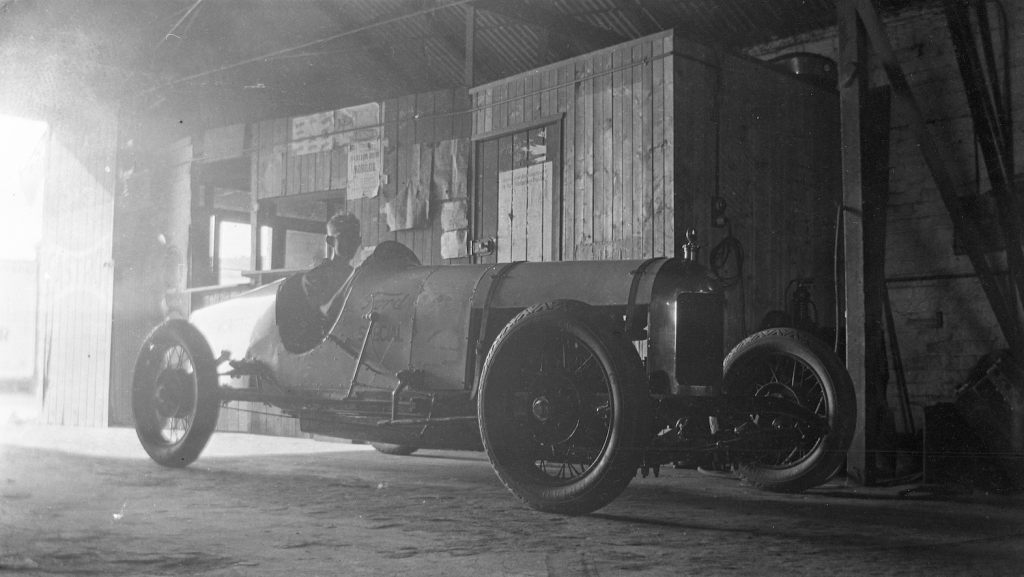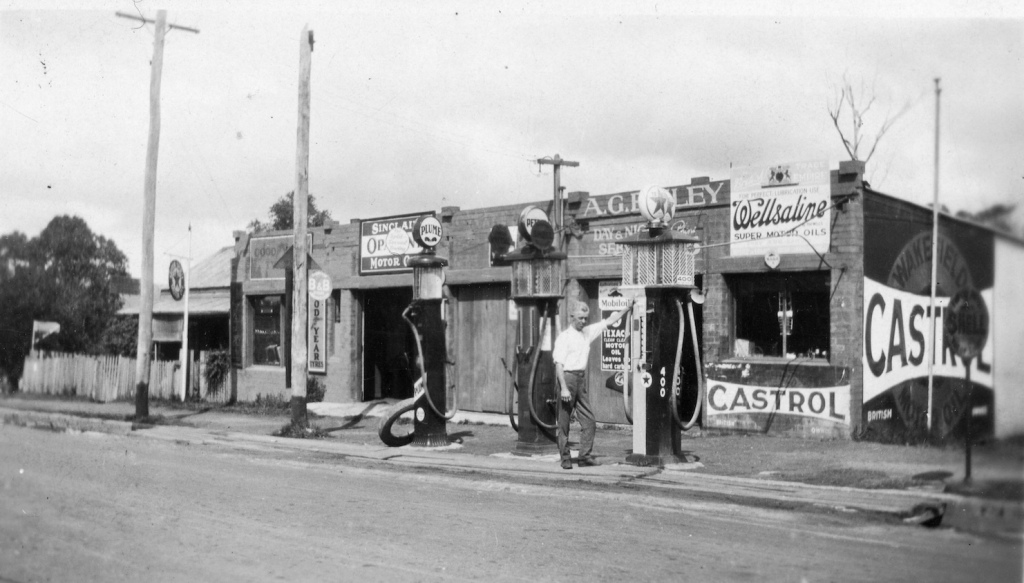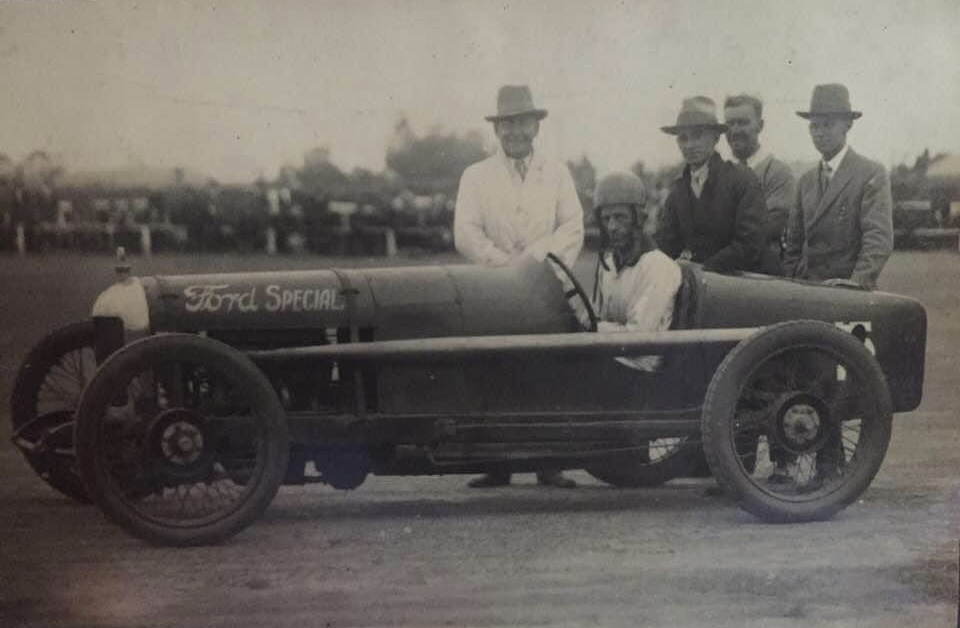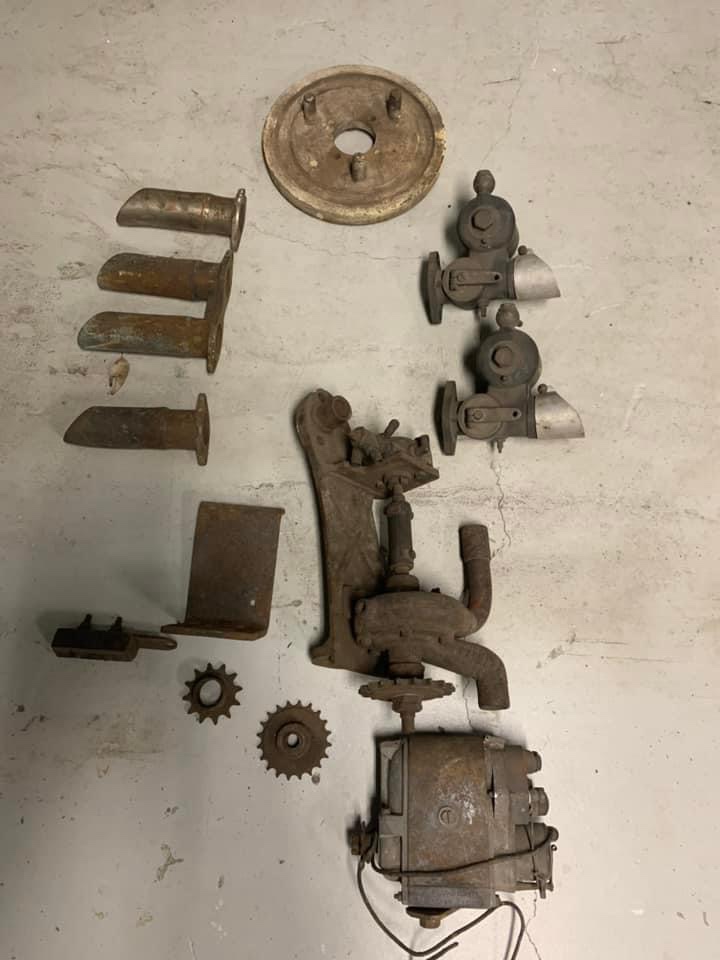
Arch Tuckett’s Henderson engined Midget out front of the workshop where it was probably built-off William Street, Woolloomooloo, inner Sydney in 1934…
The first race meeting in Australia for what became known as Midgets took place at Olympic Park, Melbourne in the summer of 1934, on 15th December. A motley crew of racers attacked the cinder track that evening, including Arch Tuckett.
Also on the grid were Bill Allen, who brought the sport to Australia, George Beavis, Barney Dentry, Charlie Spurgeon, Bill Thompson, Cec Warren, P Bouker, Lance Burgess, Fred Curtis, Arthur Higgs, Les Gough, Bruce Leckie, G Malone, J Farmley, A Shaw and Bob Finlay who was Australia’s first Midget champion.
Although there had been car racing on oval track venues around Melbourne such as the 1 mile Richmond Racecourse in Melbourne’s inner east and the bayside Aspendale track since about 1913- it was not Midget racing but events between larger dimensioned light cars ‘somewhat akin’ to American Championship Cars.

The ‘Big Cars’ at Wentworth Park in November 1933. L>R Fred Braitling 1924 Alvis s/c, Charlie Spurgeon Fronty Ford Spl and Don Shorten Rajo Ford Spl. This is the race meeting referred to below in the text (S Hood)
In Sydney an organisation known as the ‘Dirt Track Car Racing Club’ (DTCRC) ran speedway meetings at Granville Showgrounds from 1932 and made an impression on the Sydney oval track scene. These cars were bigger machines including Rajo and Fronty Fords, Overland Miller and Morris Specials. They were putting on a good show at Granville but were a dismal failure as a spectacle when tried on the shorter Wentworth Speedway quarter mile in November 1933.
A year later several of the leading drivers of the DTCRC including Bruce Leckie, Charlie Spurgeon and Arch Tuckett gathered in Melbourne with the rest of the pioneering members of ‘The Midget Car Drivers Association of Australia’ to commence the new sport at Olympic Park.

Wentworth Park, Glebe. Midget race during the 1935/6 season L>R Arthur Wylie, speedway racer, constructor, road racer and ‘Australian Motor Sports’ magazine founder/publisher, Archie Tuckett and Sam Aggett. No chassis/engine details sadly. I worked in Glebe for 12 months- is that big building still there? (VS)
The first race meeting for Midgets in New South Wales was at Wentworth Park in Wattle Street, Glebe on 5 October 1935.
Sixteen drivers contested scratch races for A and B grade drivers, triangular match races and 5 lap handicap events. The first race of the afternoon was the A Grade 5 lap scratch won by none other than Arch Tuckett who led home Bruce Leckie and four times Australian Grand Prix winner Bill Thompson in a time of 1 minute 52.5 seconds. So, ‘our’ Archie won the first Midget race in NSW.
All the Midget Drivers Association competitors were well known guys from the ranks of road racing (such as Dentry, Thompson, Warren) former motorcycle and sidecar riders from the old concrete saucer Maroubra days and dirt track speedway sidecar riders who would all be unfamiliar with Midget car racing.

(S Hood)
Tuckett’s car looks so immaculate I suspect its just completed, perhaps the workshop built the car in whole or in part. Little is known about the specification of it other than that it is powered by a Henderson four cylinder, air cooled motorcycle engine and is no-doubt based on established American practice of the day. Let me know if you can add details about the cars specifications.
I know that part of the world reasonably well, the design and branding consultancy I was a part of was located at 160 William Street for a few years, i’ve poked around many of the lanes between William Street and Woolloomooloo Bay. Using the evidence- part of a street name on the fence, and the number 252 in the other photo- I think the address may be 252 Dowling Street just off William Street. This fits with the caption together with Sam Hood’s photos on the State Library of New South Wales Flickr post of these amazingly clear, evocative shots. Wonderful aren’t they?

Arch Tuckett with the Midget he bought from Duane Carter after the 1937/8 Summer NZ Tour he contested. The chassis was built by the Technical Institute in Alameda California in 1935. Originally built with a Continental Star engine, here it is fitted with a modified A Model Ford unit (G McIsaac)
As to Tuckett himself, variously said to be from Queensland and Victoria, he built the car pictured himself and raced it to Queensland and Victorian State Championship wins.
He travelled to New Zealand to contest the first Midget races there, contesting events held at Western Springs Stadium in the summer of 1937/8 in Auckland.
At the end of that tour he bought the ‘Alemite Lubricant Special’, a professionally built, Continental Star engined racer from Duane Carter, one of five Americans on that tour. He raced that chassis very successfully in South Australia, Victoria and New South Wales before emigrating to New Zealand in 1940, subsequently enlisting in the RNZAF.
The car featured in this article, his first Midget, was sold to Kiwi ‘Pee-Wee’ Anderson.
The Alemite car exists, restored in NZ, it would be interesting to know what became of the Woolloomooloo built car! Similarly what became of Arch?…

Wonderful cover of the Olympic Park, Midget racing meeting program, 14 March 1936 (D Zeunert Collection)
Etcetera: Motor Racing at Olympic Park, Melbourne…
The current site of ‘AAMI Park’, one of Victoria’s premier football and rugby Stadiums, is situated within the city’s leading sports precinct nestled between the Yarra River and Melbourne Park, the site has served a myriad of purposes including motorsport. This section of the article is of arcane interest to Victorians only I suspect. But it was interesting to me just how many iterations of motorsport there were in an area many of us know so well. The piece is a truncated version of the AAMI Park site history.
Bound by nature
‘Prior to European settlement of Melbourne in 1834, the Yarra River Valley was inhabited by the Wurundjeri people of the Kulin Nation. The area has always been idyllic for recreational pursuits. Surveyor-General Robert Hoddle surveyed Melbourne in 1837 and set the boundary for ‘Government Paddock’, an area that comprised the current Yarra and Melbourne & Olympic Parks. The lower reaches of the paddock near the Yarra (i.e. AAMI Park) were quite marshy, a chain of lagoons proving popular with duck shooters.
These riverside pastures of what was also called ‘Richmond Paddock’ became the first location for Melbourne’s Zoo. The Zoo area became the ‘Friendly Society’s Gardens’. The Combined Friendly Society used the land for athletic carnivals and social events. The Yarra constantly flooded until 1896 when the Board of Works realigned the river between the City and Richmond.
 The League of Victorian Wheelmen completed a banked cycling track in 1897, which included a grandstand, bar and a range of amenities. Motocyclists also used the 32-35ft wide asphalt track which was enclosed by a picket fence. However, their machines became too fast and the track useless for racing purposes. As well as other cycling and running tracks (often flooded or swamp-like) the area was used for football, tennis, rugby union and women’s cricket either side of the century’s turn.
The League of Victorian Wheelmen completed a banked cycling track in 1897, which included a grandstand, bar and a range of amenities. Motocyclists also used the 32-35ft wide asphalt track which was enclosed by a picket fence. However, their machines became too fast and the track useless for racing purposes. As well as other cycling and running tracks (often flooded or swamp-like) the area was used for football, tennis, rugby union and women’s cricket either side of the century’s turn.
The ‘Amateur Sports Grounds’ basically consisted of two ovals – one rough and ready, the other encircled by the cycle track. On these fields were turf wickets for cricket, and two adjacent double tennis courts. Athletics was still a regular feature, the St Stephens Harriers using both ovals regularly.
In 1915 the Great War halted preliminary work on a private company’s £5000 motordrome, based on the popular yet extremely dangerous board tracks of the United States. Pioneered by Jack Prince, these banked tracks were capable of handling speeds up to 100mph, but overpowered motorbikes caused mayhem on a weekly basis.

Thrills ‘n spills at the ‘Drome
Melbourne Carnivals Pty Ltd developed and leased the site until the conclusion of World War II. Undeterred by carnage on similar tracks in America, dynamic and colourful local entrepreneur John Wren was a driving force (along with ace promoter Campbell) in reviving the previously shelved ‘Melbourne Motordrome’. Built over 18 months on the old cycle track, it opened on 13 December 1924 at a cost of around £30,000.
A campaign led by defunct newspaper, The Argus, condemned the appropriation of public space for commercial activities, however authorities maintained the land was still open to the community. From the venue’s inception official complaints about the noise levels arose – the ‘peace and tranquility’ of the nearby MCG test match disturbed, along with local residents. Criticism subsided as people attended all manner of entertainments such as wrestling. Few were keen to make an enemy of the powerful Wren in any case- he was one of those chaps who played right on the envelope of legal and bent activity in many areas.
The treacherous 629 yard concrete drome’s primary attraction was two lap ‘professional wheel racing’ events. Recruited by ace promoter Campbell, American star motorcyclists Jim Davis, Ralph Hepburn and Paul Anderson regularly thrilled crowds whilst Ron Hipwell was the local favourite. Crowds nearing 30,000 also thrilled to eclectic programs that featured sidecars, cycling, athletics and wrestling bouts. Some novelty events bordered on the farcical; racing ostriches were imported from South Australia in December 1926, but in what The Argus labelled ‘a complete fiasco’, the confused and terrified beasts (with cardboard cutout ‘jockeys’) wandered aimlessly, scampered in all directions, or simply stood stupefied. ‘Motor Push Ball’ was another bizarre affair, as were children being pulled by billy goats in two wheeler carts.
Tearing around at over 80 miles an hour with no brakes on the steep banks, it was little surprise that five riders lose their lives, the track earning the nicknames ‘Suicide Track’ and the ‘Murderdrome’. Due to instances of flying debris and that the vertical wall at the top was only half the height recommended by Jack Prince, the Motordrome’s innovative ‘saucer’ track featured ‘Danger – don’t lean over’ signs and additional strategically placed fencing. A red danger line half way up the daunting 48 degree bank acted as a guide for riders, however serious trouble often ensued when oil spilt on the track, riders ‘wobbled’, skid on the painted red line or tried to ride more than three abreast.
In one spectacular crash, Hipwell suffered concussion and assorted injuries (including his hip!) and never regained the form that saw him once defeat Davis in front of a full house. More tragic accidents saw Alec Staig, Allan Bunning, Charles Grigg, Reg Moloney and two teenage spectators lose their lives. Riders even contended with foolish attempts at sabotage; such as double sided tacks, or on one occasion, a five foot length of barbed wire that officials thankfully spotted. The final tragedy, local star Jimmy Wassell on 2 January 1932, appeared to be the last straw. Crowds declined and racing was restricted to slower side-cars in the final season.
Jumping aboard dirt track’s motorcycling’s wave of popularity in Britain, a new 494 yard track was added by 1928, enclosed by the ‘drome. Huxley and Van Praag were stars of these meetings. Cycling also became popular as the Great Depression took hold. The nature of this unique ‘velodrome’ lent itself to motor-paced feats such as Legendary cyclist Sir Hubert Opperman covering 100 miles in 90 minutes in 1930 and in a world famous performance, 1000 miles in 28hrs 55 mins. He also broke the world record for the dangerous five mile motor paced event. The Motordrome also hosted the historically significant Austral Wheelrace five times between 1923 and 1929.
The world’s richest professional footrace, ‘The Melbourne Thousand’ was established by Wren in 1928. The inaugural £500 winner’s prize went to South Melbourne star footballer Austin Robertson, the sprint last run in 1932. Other much hyped events such as the ‘World’s Championship’ sprint appeared on ‘sensationally historic’ athletic programs.
On 4 June 1932 the Motordrome became part of VFL/AFL history when Melbourne played the first of three VFL home games owing to the MCG undergoing resurfacing works. Melbourne lost all three games at the Motordrome.

Page of competitors, Midget events march 1936 (D Zeunert Collection)
Olympic Park Speedway
An untenable safety record, and declining financial viability, saw 20 charges of dynamite reduce the ‘Drome to rubble in 1932. The venue was reconstructed as the ‘Olympic Park’ sporting arena in 1933. Interestingly, this reference predated the ’56 Games. Said to better reflect the usage of the site than ‘Amateur Sports Grounds’, the name was prophetic, if not lacking in logic. Promoted successfully by Dick Lean Snr, popular midget speedcars debuted and were pioneered in Australia here in 1934 on a newly constructed dirt track around the sporting field.
Football returned on 30 March 1935 when a floodlit game between 1934 Grand Finalists Richmond and South Melbourne remarkably drew 25,000 spectators (causing Jack Dyer to walk to the ground, unable to get on the packed trams). The practice match was interspersed with midget car races in the breaks. Amid some controversy, around this timeWren almost closed a deal for Richmond to relocate to Olympic Park.
The Australian Imperial Force assumed control of Olympic Park in 1940, although with the permission of the Fuel Board one last speedway meeting was held on 1 April 1946 in aid of St Vincent’s Hospital.
Continued petrol rationing spelled the death knell for the speedway in the aftermath of WW2. The venue met with the wrecking ball in 1946 but few local residents lamented the demise of the noisy motorsports. Further deconstruction occurred inadvertently when a fire destroyed a large wooden grandstand in 1951.
Olympic Park lives up to its name
The welcome 1956 Olympic Games transformation began in 1951. A new sports arena at the southern end of the AAMI Park site hosted the field hockey preliminary rounds, subsequently known as the Eastern Sportsground or the No. 2 Oval. A 4400 seat, 333 metre long velodrome was also constructed, situated on the northern/Swan Street side at a cost of around £120,000. One of the fastest tracks in the world, it was made of reinforced concrete over a New Zealand pine base. Our cyclists won a gold and a bronze at the ’56 Games.

A couple of unidentified cyclists during the 1956 Olympics Velodrome, Olympic Park 3 December ’56
Entertaining the masses
The Victorian Amateur Football Association took up residence at the Eastern Sportsground in 1957, using the venue as its administration base and a weekly marquee game.
The Victorian Rugby Union competition used the Eastern sportsground, as did three Victorian Soccer Federation teams and even the Australian Equestrian Federation held twice yearly championships here. In one of Olympic Park’s more controversial moments, hundreds of protesters against the 1971 Springbok rugby tour clashed with mounted police armed with batons on 3 July. The demonstration was a forerunner to other protests around Australia and preceded Australia pulling out of its upcoming cricket tour of South Africa. Several court cases ensued with accusations of assault levelled towards, and against police. The game itself saw South Africa thrash Victoria 50-0.
A £50,000 investment by the Melbourne Greyhound Racing Association saw their relocation from Arden St. North Melbourne to a redeveloped Eastern Sportsground in 1962. On 20 August 6000 punters braved the cold for the first meeting. The velodrome was demolished in 1972, becoming a 800 space carpark, and the following year saw a new $6m 2200 seat grandstand built for greyhounds, soccer and rugby. The facilities pre-empted the dishlicker’s halcyon days which lasted until the 1980’s. Regular crowds of 5000 were also entertained by athletic races during the Monday night program, as well as promotions tied to Moomba, glamorous models and various celebrities.
A changing landscape
TThe Eastern Sportsground was upgraded with a synthetic pitch, practice running track and throwing area to coincide with the 1985 World Veterans Athletic Championship. As well as facilitating commercially viable sport and entertainment, Olympic Park Management’s other primary objective to increase the variety of sports. Consequently, hockey and American football utilised this field during winter, the latter playing their Victorian Championship on the ground in 1985-1993.
In November 1991, billowing smoke permeated through the greyhound track grandstand causing the evacuation of 2000 enthusiasts, moments after the last race. Forty firemen were dispatched to the blaze that began in a storeroom. The last race was run in February 1996 as 3000 punters sadly bid farewell, the club relocating to Broadmeadows.
The old Eastern Sportsground was reborn as Edwin Flack Field whereupon Collingwood used it as their training ground from 2004-06 – some irony given their legendary patron John Wren had built the Motordrome on the same patch of turf.

City of Melbourne folks- the area we are referring to is the modern white stadium and Olympic Park to its left beside the River Yarra- one can readily see that motor racing 1 km from a modern metropolis even in the 1940’s was a bit of a stretch! MCG right middle of shot as you cricket lovers, god help you, would know
State of the Art Stadium
Plans for the new stadium were originally conceived when Melbourne bid for a new Super 12 franchise. Upon being beaten by Perth, it didn’t take long for the plans to re-emerge. In April 2006, the Victorian Government announced a new 20,000-seat stadium would be built at Olympic Park to host Rugby League and Football. Melbourne Victory.
Construction commenced in late 2007 on the site of Edwin Flack Field- AAMI Park officially opened its doors on 7th May 2010, hosting the Rugby League ANZAC Test Match between Australia and New Zealand. The game attracted a near sell-out crowd of 29,442. As well as the Victory, Storm and Rebels; the Melbourne Demons Football Club (AFL) also have their training and administrative base at the venue, training on the adjacent sporting field.’
Built at a cost of $267.5 million, AAMI Stadium features a distinctive cutting-edge Bioframe design with a geodesic dome roof which substantially covers the seating area and is a great visual reference point when heading into town from the inner-East through South Yarra…
Bibliography…
australianspeedway.com, vintagespeedway.com, article by Ken Wylie, David Zeunert Collection
Photo Credits…
Sam Hood, State Library of New South Wales, Gordon McIsaac
Finito…



































